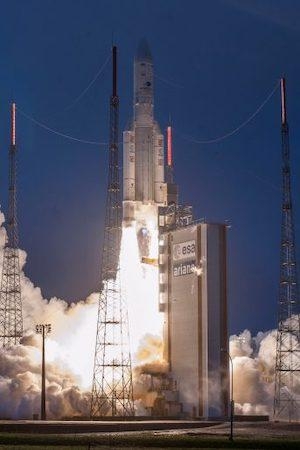Ariane 5 Delivers On Arianespace’s First Launch Of The Year
Arianespace opened its 2019 mission activity by successfully orbiting a pair of telecommunications spacecraft – Saudi Geostationary Satellite 1/Hellas Sat 4 (HS-4/SGS-1) and GSAT-31 – using the company’s workhorse Ariane 5 launch vehicle.

This flight to geostationary orbit, performed from the Spaceport in French Guiana, delivered a payload lift performance estimated at 22,000 pounds. That included the two spacecraft, along with the dispenser system and integration hardware in Ariane 5’s dual-passenger configuration.
Arianespace CEO Stéphane Israël confirmed the success in post-launch comments from the Spaceport’s Jupiter control room. “For the first Ariane 5 launch of the year, our heavyweight vehicle has once more performed flawlessly,” he said. “Congratulations to all!”
Deployed first in the flight sequence 27 minutes after liftoff, HS-4/SGS-1 is a geostationary “condosat” for Saudi Arabia’s King Abdulaziz City for Science and Technology (KACST) and Greek-Cypriot satellite operator Hellas Sat, an Arabsat subsidiary. Designed, assembled and integrated by Lockheed Martin Space, HS-4/SGS-1 will operate from an orbital position of 39 deg. East, with a coverage area that includes Europe, South Africa and the Middle East.
The Arianespace CEO acknowledged the direct customer for HS-4/SGS-1, Arabsat, and called this 11th Arianespace mission at the service of the Riyadh, Saudi Arabia-based telecommunications operator a “new bright success.”
The Saudi Geostationary Satellite 1 communications payload will provide advanced Ka-band spot beam communications services for KACST, a government organization responsible for promoting science and technology in Saudi Arabia. The Hellas Sat 4 communications payload will deliver advanced Ku-band regional beam communications services for the Arabsat subsidiary.
GSAT-31 was carried in Ariane 5’s lower payload position and released second in the sequence for today’s mission, which is designated Flight VA247 in Arianespace’s numbering system – representing the 247th launch of an Ariane-series launch vehicle.
The spacecraft was designed and manufactured by the Indian Space Research Organisation (ISRO) and will provide Ku-band communications services from an orbital slot at 48 deg. East, helping “bridge the digital divide” with coverage across the Indian subcontinent.
Israël noted that GSAT-31 was the 23rd ISRO satellite orbited by Arianespace and Ariane-series launchers, tracing the relationship back to India’s APPLE small experimental communications spacecraft, lofted in 1981 by an Ariane 1 version. He added: “Arianespace is honored ISRO has entrusted Ariane 5 for two launches back-to-back, with the last Ariane 5 of 2018 launching GSAT-11, and today the first one of the year 2019, which orbited GSAT-31!”
With today’s success, Arianespace kicks off a busy launch schedule in 2019 – which targets up to 12 missions from the Spaceport with the heavyweight Ariane 5, medium-lift Soyuz and lightweight Vega.
(Image provided with Arianespace news release)
 Samson Sky Hits the Wind Tunnel
Samson Sky Hits the Wind Tunnel ANN's Daily Aero-Term (05.22.24): LAHSO
ANN's Daily Aero-Term (05.22.24): LAHSO Aero-FAQ: Dave Juwel's Aviation Marketing Stories -- ITBOA BNITBOB
Aero-FAQ: Dave Juwel's Aviation Marketing Stories -- ITBOA BNITBOB ANN's Daily Aero-Linx (05.19.24)
ANN's Daily Aero-Linx (05.19.24) ANN's Daily Aero-Term (05.19.24): Back-Taxi
ANN's Daily Aero-Term (05.19.24): Back-Taxi



